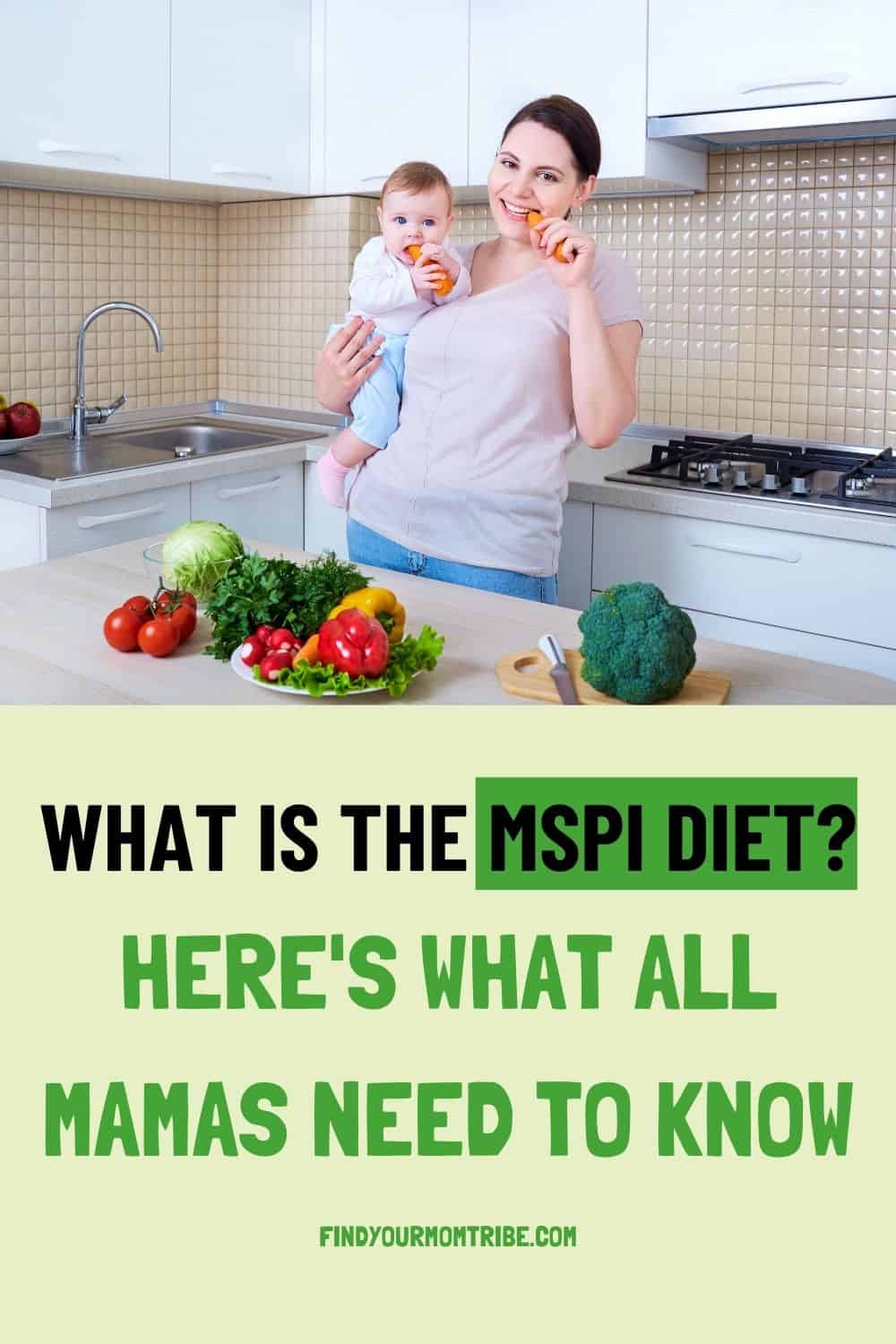Have you recently been told that your little one is lactose intolerant? Are you having trouble adjusting to their unexpected milk sensitivity and milk soy protein intolerance (MSPI)?
Before you start worrying about breastfeeding a baby with substantial food allergies and searching for soy-free milk alternatives, I’d like to introduce you to the MSPI diet.
You’re probably wondering what this unusual diet is, what it entails, and whether it affects breastfeeding, am I right?
Well, let’s start with the basics.
MSPI is a type of food allergy where the baby is incapable (only temporarily though) of digesting soy proteins as well as the proteins found in cow’s milk.
The moment your gastroenterologist (or pediatrician) suspects any type of lactose intolerance or intolerance to soy products and dairy products, they’re going to suggest a specially designed diet.
RELATED: Symptoms, Diagnosis And Treatment Of Egg Intolerance
Although the MSPI diet can be challenging, as limiting milk and soy products isn’t simple, there’s a light at the end of the tunnel for all the breastfeeding moms out there.
As a mom who has spent a couple of years on this diet (and successfully breastfed), I’m going to share some really important tips and tricks with you that’ll help you adjust to your new (temporary) reality.
If you follow the tips below, you won’t have to worry about your baby’s allergens, your breast milk supply, or how sustainable a dairy-free lifestyle will turn out to be.
You’ll be pleasantly surprised at how much you’re allowed to eat (more than just veggies and meat, I promise!) and how easy it will be to continue breastfeeding.
Here’s everything you need to know about this amazing diet.
How Exactly Does MSPI Get Diagnosed?

For starters, keep a close eye on your baby (which I’m sure you do anyway). The minute you notice unusual fussiness or bad reactions to milk or dairy products, consult your pediatrician.
It took us a while to figure out what the issue was, so the sooner you make contact the better. If your baby is irritable, has colic-like issues, reflux, or you notice mucous in their stool, you might be joining me in the MSPI mamas club.
If this is the case, please know that it is of paramount importance to follow your doctor’s advice. That’s the safest way to get a confirmation that it is, in fact, MSPI, and be able to start your MSPI diet promptly.
There’s a chance you might have to do stool studies, to make sure there’s no blood present. This is something your gastroenterologist will inform you about if it becomes a necessity.
All of this might sound a bit frightening, but there’s no reason to panic. Keep in mind that this is a temporary situation that your little one is very likely to outgrow in a few months!
When you finally get a diagnosis, it’s important to monitor your baby at all times. This will require you to work closely with your doctor.
Depending on your particular situation, they might choose a few different paths.
In my case, we had to monitor my baby’s weight to ensure everything was in order and that my little one was gaining weight.
What you might find surprising is that there’s a chance you’ll also have to closely monitor your baby’s moods (yup, you read that right).
If they’re fussy, what’s the cause? Is your baby teething, hungry, sleepy, dealing with eczema, rash, or is it MSPI related? From time to time, as challenging as this may be, this is something you’ll have to get to the bottom of.
And sometimes, an elimination diet does the trick, which is something your doctor will broach if need be.
None of this means that your breastfed baby will have to “suffer” through this forever. Just stick it out for as long as it takes and do your best to adjust to the situation.
Once it’s over, you and your angel can both go back to eating without constantly having to worry about the contents.
How Does Your Baby Develop Milk Intolerance?

The cow’s milk proteins that you drink travel through your bloodstream to your breast milk, and eventually find their way to your little one’s stomach.
These proteins (including soy proteins) tend to be very large, which is why our bodies digest them by breaking them down to make the process easier.
For some babies, it’s difficult to do this successfully, and that can result in these large particles getting stuck in their bowels.
This, in turn, makes your baby extremely fussy and irritable as it causes diarrhea, spitting up, and in some cases, blood in the stool.
Should You Switch To A Special Formula?

This is an option, but an expensive one. It is entirely up to you to decide whether you’d like to opt for the MSPI diet or have a formula-fed baby.
As already mentioned, this diet isn’t a walk in the park, but it’s also 100% manageable if you commit to doing it right. However, there’s absolutely nothing wrong with choosing a formula if that’s the best option for you.
Switching from breastmilk to formula is perfectly okay, as many of my mom friends did it and their babies were just fine!
There are many allergy-friendly places and labels now, and I’m sure it’ll be easy to find what your baby requires. May I also suggest trying the Alimentum formula, as recommended by a close friend of mine.
If you end up formula-feeding your baby, your insurance company will likely cover some of the expense, granted that you may have to ask your pediatrician for a prescription, as well as a medical necessity letter.
Everything There Is to Know About The MSPI Diet

If you’ve decided to start the MSPI diet, you’re going to have to wait for around two weeks for it to take effect.
This means that it will take approximately two weeks for those proteins to fully disappear from your breast milk, even though you should be able to notice some changes within the first few days.
The more time passes, the less protein your breast milk will contain, and the more favorable it’ll be for your infant!
A quick tip: If you’re starting the MSPI diet while pregnant, it’s recommended to start it 4 weeks before giving birth.
Now let’s get to the basics of the diet. What food are you allowed to eat and what should you avoid? The first thing I’d like to point out is that you’ll probably become a label reading pro, and fast.
There’s no going around this, so you’ll have to say goodbye to soy-protein products and dairy products. That means no more creamers, your favorite ice cream, yogurt, or cheese.
I’ll discuss some pretty good alternatives below, so it’s not all doom and gloom. You should also make sure to read the labels closely, as there are sometimes proteins in non-dairy foods too!
Unfortunately, soy protein can sometimes be found in veggie burgers, lots of Asian meals, as well as veggie nuts.
Since soy protein is derived from soybeans, you can also say goodbye to edamame and soy sauce, and even some breads.
RELATED: Easy Traditional And Gluten-Free Soda Bread Recipe
Below, you’ll find a more detailed discussion of all the foods you need to steer clear of and the ones you’re allowed to eat, so take notes!
FOODS YOU NEED TO AVOID:

Here’s a list of all the foods and food ingredients you need to steer clear of while on the MSPI diet:
Milk products: Cow’s milk, goat milk, butter, all types of cheese (especially cottage cheese), yogurt, creamers, half and half, whey (including whey protein and powder), nonfat dairy milk, custards, puddings, and Ovaltine.
Soy products: Soy protein, soy yogurt, edamame, soybeans, tofu, soy flour, miso, soy milk, casein, vegetable protein, starch, broth, and gum (soy lecithin is okay, though).
Starches: Sandwich bread, as well as all bread and rolls that contain milk, refrigerator rolls, hamburger, and cheeseburger buns (which I found especially sucky), and bread crumbs.
I’d also like to encourage you to pay close attention to the labels for donuts, biscuits, sweet rolls, muffins, waffles, and pancakes. It’s also possible to find whey and milk in some crackers.
Fats and oils: Say goodbye to margarine that contains milk or whey, your favorite snack dips, cream cheese, creamy sauces, creamy salad dressings, and milk gravy.
Soups: Avoid chowders and all types of creamy soups. It’s also important to be mindful of the fact that some canned soups and dehydrated soup mixes contain whey.
Vegetables: Breaded and creamed veggies, as well as those in sauce or butter.
Seasonings: Keep a close eye on which seasonings you use, as some of them contain whey!
Eggs: Creamed eggs, any eggs with milk, and unfortunately (my favorite) scrambled eggs.
Desserts: Read the label on any store-bought cake, and avoid cookies and any type of dessert that contains milk, cheesecake, and unfortunately for some – even caramel.
RELATED: What Not To Eat When Breastfeeding: Specific Foods To Avoid
FOODS YOU ARE ALLOWED TO EAT:

Finally, we’ve come to the part you’ve been waiting for. You’re probably convinced that there are TONS of stuff you like that you won’t be able to eat, right? Allow me to reassure you about that.
First off, I must insist that you ALWAYS read the labels before you eat anything. This is essential because products can sometimes change and you could accidentally eat something that you shouldn’t.
Now that we got that sorted out, let’s see what delicious foods can stay on your menu during this dairy-free diet.
Bread: When it comes to bread, I’d say your chances are 50:50. While some types of bread are off-limits, it’s not that difficult to find bread, rolls, or even buns that are MSP free.
In my experience, all Italian bread is totally fine, and it goes great with peanut butter and jelly. Go ahead and try it!
Almond Milk, Rice Milk, or Coconut Milk: You can also have plain or vanilla, and choose anything from Blue Diamond Almond Breeze, Pacific Natural Foods, Rice Dream, or West Soy Rice.
Beverages: Here’s what you don’t have to give up (yay): Fruit and vegetable juices, milk-free cocoa, powdered fruit-flavored drink mixes, soda, and most importantly – coffee (this was a big one for me).
Meat: Most meats are okay, you just have to be careful what you put on them. Yes, this means that you can indulge in turkey, fish, chicken nuggets, hot dogs, soy meat, or even kosher meat.
Basically, you can have any meat, as long as it’s prepared by roasting, baking, or broiling with allowed ingredients.
Vegetables: It’s particularly recommended to eat lots of green leafy vegetables because they are high in calcium.
Seasonings: Salt and pepper are among the allowed seasonings. Can you imagine cooking without them? Other than that, you can keep using plain herbs and spices, ketchup, vinegar, pickles, vanilla extracts, and olives.
Sugary foods: I’ve always had a sweet tooth, so I was elated that I didn’t have to give up sugar. Here’s what’s okay to eat: Confectioner’s sugar, as well as brown, powdered, and you guessed it – granulated sugar.
Moreover, you can also keep honey, jellies, molasses, jams, preserves, and marmalades on your menu. As long as they don’t contain milk, hard candies are also acceptable.
Pasta: I’ve found that almost all pasta is fine (obviously, you won’t have cheese ravioli, but the regular ravioli is permitted). While you’d normally eat pasta with sauces, you should always read the labels beforehand.
Grains and starches: Rotella bread is okay (and delish), other than that you can have Panne Provincio‐Artisan Bread, but the organic one, Hy Vee bread, rice, pasta, and of course – potatoes.
Fridge items: Deli meat (but not smoked, as it contains soy), hummus, eggs, bacon, salsa, and pepperonis (which I ate tons of and it was completely fine).
Pantry foods: Oreos, unflavored potato chips, peanut butter (and jelly), tortillas, graham crackers, taco shells, pretzels, saltine crackers, and most cereal.
I love muffin mixes, and I’m happy to say that they’re on the ‘keep’ list too.
Desserts: I know that I put ice cream on the no-go list, but have I mentioned that ice cream made with soy is okay? Additionally, you can have tapioca with fruit juice, off-brand sandwich cookies, and carob candy bars.
What I also indulged in was loads of Hydrox cookies, my favorite movie snack – popcorn, and homemade cookies, made with vegetable shortening and containing zero milk.
Don’t Worry About Occasional Slip-Ups

You’re only human, and it’s okay if you slip up and accidentally eat something you weren’t supposed to. Being on the MSPI diet is no small task, as there’s a LOT to be mindful of.
Breastfeeding an infant with milk soy protein intolerance is daunting, as you’ll constantly be wondering whether the food you just had was gluten and soy-free and if you may have missed a dangerous ingredient on the label.
Been there, done that, and let me tell you – some days were more challenging than others. All you can do is try your best and consult with your pediatrician if you’re unsure about anything.
So, my advice to you – be kind to yourself. I know that you’re taking all the precautions necessary because you’d never intentionally endanger your child.
If your angel is being fussy, it doesn’t have to be due to MSPI, as babies tend to cry a LOT (which I’m sure you already know).
This too shall pass, and before you know it, you’ll be able to eat what you want without worrying about it affecting your baby.
I know that all of this sounds overwhelming but I promise you it gets easier with time. Plus, it only lasts between six to nine months, and I know you can handle that.
Just remember that this is all for the well-being of your little munchkin and I promise that you’ll find it much easier to cope. You’ve got this!
Like this post? Please share or pin it for later. You can also stay in the loop and follow us on Facebook, Instagram and Pinterest.

This post contains affiliate links. Please see our full disclosure for more info.

